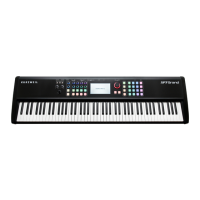41
5-1-3-4 Flanger
The Flanger effect provides 6 parameter settings:
Waveform - Select from 2 waveforms shapes: Triangle
and Sine.
Rate - Determines the frequency of the LFO modula-
tion. Higher values equal faster modulation rates.
Depth - Sets the range of delay time modulation.
Higher values equal deeper comb filtering variations.
Feedback - Controls the amount of effected signal fed
back into the input to intensify the flanging effect.
5-1-3-5 Phaser
The Phaser effect provides 5 parameter settings:
Waveform - Select from 2 waveforms shapes: Triangle
and Sine.
Rate - Determines the frequency of signal modulation.
Higher values equal faster rates.
Depth - Sets the range of peaks and notches created in
the modulated signal.
Feedback - Controls the amount of effected signal fed
5-1-3-6 Wah-Wah
There are 4 types of “Wah-Wah” effect available: Dynamic
Up (Dyn Up), Dynamic Down (Dyn Down), Dynamic Up
Sharp (DynUp Sharp), and Low Frequency Oscillator (LFO).
Dynamic Up (Dyn Up) - This flavor of wah-wah increasingly
opens the filter with higher (harder) velocity playing.
Dynamic Down (Dyn Down) - ‘Dyn Up’ behaves in reverse
of ‘Dyn Up’ and increasingly opens the filter with softer
(lighter) velocity playing. Harder playing increasingly closes
the filter.
Chapter 5
Chapter 5. FX Editing
Delay - Adds delay in front of the modulated signal. Higher values equal longer delay line times and thus phase
variations.
Dry/Wet - Determines the balance between unaffected (dry) and effected (wet) signals. Higher values equal a
more effected signal.
back into the input to intensify the phasing effect.
Dry/Wet - Determines the balance between unaffected (dry) and effected (wet) signals. Higher values equal a
more effected signal.
Dynamic Up Sharp (Dyn Up Sharp) - This is similar to ‘Dyn Up’ but with a sharper resonant response.
Low Frequency Oscillator (LFO) - The LFO option creates a tempo-sync’ed ‘auto-wah’ effect.
The editable wah-wah parameters are: Filter Type, Frequency, Resonance, Dyn Sensitivity (Dyn options only), Decay (Dyn
options only), LFO Rate (LFO option only) and LFO Depth (LFO option only).
Filter Type - Select from Low Pass and Band Pass options. The ‘low pass’ filters out higher frequencies whereas the ‘band
pass’ allows frequencies within a certain range to pass and rejects (attenuates) frequencies above and below that range.
Frequency - Sets the reference frequency of the above filter. For the Low Pass option this sets the frequency above
which sound get attenuated. For the Band Pass, this defines the center of the frequency region allowed to pass through
the filter.

